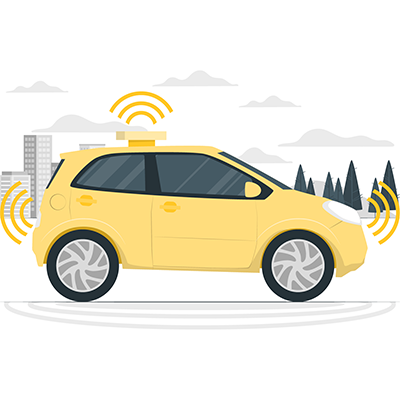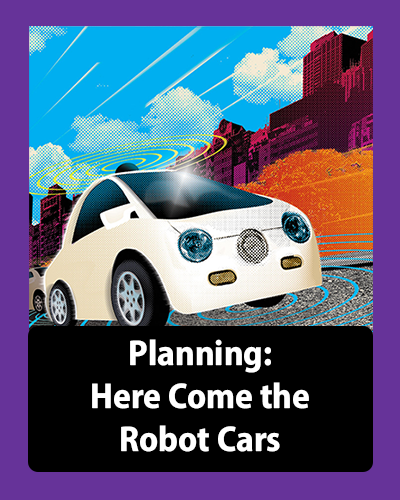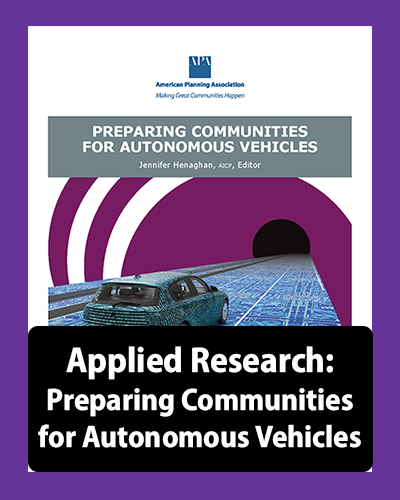KnowledgeBase Collection
Autonomous Vehicles
p class="featured"

Image by storyset on Freepik
Autonomous and connected vehicle technology is expected to transform the nation’s transportation system over the coming decades, with major implications for the planning and design of cities and regions. In fact, autonomous vehicles (AV), also known as driverless or self-driving cars, have been sharing city streets, through pilot programs, for several years already.
AV technology, as defined by the International Society of Automotive Engineers, ranges from a baseline of no automation, up to five levels of increasing autonomy:
- Level one, driver assistance (e.g., adaptive cruise control)
- Level two, partial automation (e.g., Tesla’s autopilot)
- Level three, conditional automation (e.g., human drivers serve as backup for an autonomous system that operates under certain conditions)
- Level four, high automation (e.g., Google/Waymo test cars)
- Level five, full automation (e.g., no steering wheel in the vehicle)
From this page you can search for resources that provide background on autonomous vehicles and examples of how their widespread adoption will impact the transportation network and the built environment, as well as recommendations for policies that communities should consider to prepare themselves. And you can filter these search results by various geographic and demographic characteristics.
Contents
Featured APA Resources
Equity and Access
Access to transportation is closely linked to opportunities for employment, education, healthcare, and recreation. If autonomous vehicles are thoughtfully implemented with access and equity in mind, AV technology can expand access to these resources for users of all ages, abilities, and incomes. However, cities must take an active role to ensure that AV does not reinforce existing disparities in access.
As the transportation industry, particularly the freight sector, transitions to fleets of autonomous vehicles, there will be economic implications in terms of job loss and dislocation. Policymakers and job training organizations will need to be cognizant of the impact on access to stable, well-paying jobs, as well as the skills required by those jobs.
Transportation Network
Autonomous vehicles will have a profound impact on the transportation ecosystem. The first use cases are expected to come in the form of fleets for shared mobility providers and freight transportation, in part due to the high costs associated with AV technology that will hinder mass adoption by private users. In addition to being a potential early adopted of AV, transit providers will need to take steps to ensure that the technology is used in way that enhances and improves the mobility of their riders.
Land Use and the Built Environment
The widespread deployment of autonomous vehicles for cities and metropolitan regions will change the way we design our public rights-of-way. Sensors will allow autonomous vehicles to travel closer together than human-controlled vehicles, reducing the necessary pavement width and freeing up space for wider sidewalks, bike lanes, and other amenities. Local zoning codes will need to address requirements for passenger loading and unloading, and parking needs will change drastically if a shared use model is employed. As cities transition away from ordinances that now require large amounts of land to be used for parking and circulation, they will need to determine how best to make use of that “extra” land through new approaches to land use and zoning.
Related Collections
Artificial Intelligence and Planning
Artificial intelligence is the study and application of computer algorithms that mimic human decision-making. This collection catalogs resources that provide background and policy guidance on how local and regional planning agencies can use artificial intelligence in their work.
Complete Streets
Complete streets is an approach to planning and designing streets and street networks that prioritizes safe and convenient access for all modes and users. This collection catalogs resources that provide background and policy guidance, as well as examples that demonstrate how localities are using plans, policies, and regulations to consider all modes of transportation in the design of streets.
Scenario Planning
Scenario planning enables professionals, and the public, to respond dynamically to an unknown future. This collection catalogs resources that provide information about developing and using scenarios in local and regional planning.
Shared Mobility
Shared Mobility refers to transportation services that provide users with short-term access to transportation modes on an as-needed basis. This collection catalogs resources that provide background and policy guidance or demonstrate how local and regional agencies are taking action to accommodate or encourage ridesourcing; bike, car, and scooter sharing; ridesharing; and microtransit services.
Smart Cities
A “smart city” uses information and communication technology (ICT) to optimize citizen engagement, service delivery, and systems performance. This collection catalogs resources that provide background and policy guidance, as well as examples of local uses of information and communications technology to engage citizens, deliver services, and enhance urban systems.










